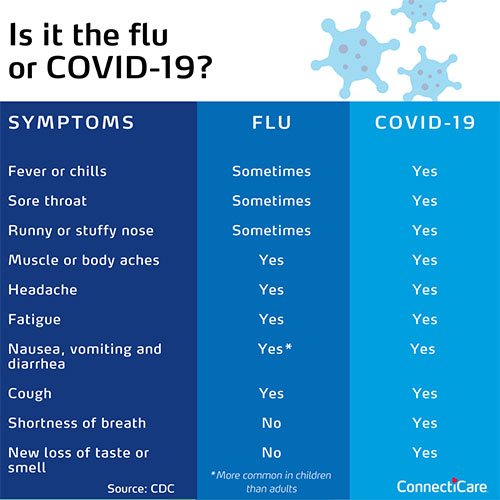This year will be a little different.
You’re not the only one confused about the symptoms and what to do. Doctors will likely have a tougher time distinguishing the flu or a cold from COVID-19 at first glance.
Many flu and cold symptoms are similar to symptoms of COVID-19. The flu, a cold, and COVID-19 may all present with a fever, body aches, and a cough, among other symptoms.
There are, however, a few key differences. For example, COVID-19 may cause a loss of taste or smell and shortness of breath. These are not typically signs of the flu or a cold.
The flu typically comes on quickly and suddenly. With a cold, you usually experience symptoms more gradually. With COVID-19, symptoms may develop between two (2) and 14 days of exposure. But you can be infected and contagious without even showing signs of being sick.

Where to turn if you’re sick.
Any time you’re ill, you want to catch it early, both to start treatment and prevent yourself from exposing others.
Contact your primary care provider (PCP) right away if you develop symptoms that could indicate flu or COVID-19. Your PCP will help you find the best testing and treatment options. Urgent care centers are another option if you think you have the flu.
Many EmblemHealth plans also cover virtual doctor's visits, so you can get medical advice without leaving home. Learn more about our telehealth policy here. Please note that telemedicine doctors cannot order lab tests — diagnostic or antibody tests — for COVID-19.
Get help immediately if you experience emergency warning signs, such as shortness of breath or difficulty breathing, pain or pressure in your chest or abdomen, dizziness or confusion, seizures, severe muscle pain or weakness, or a worsening of chronic conditions.
Have you had your flu shot?
It’s the best way to protect yourself from the flu. The flu shot is recommended for most people over the age of 6 months, but talk to your doctor if you have any concerns about receiving the vaccine.
Stop the spread with these prevention tips:
There are things you can do to help prevent catching or spreading the flu, the common cold, COVID-19, or other contagious illnesses:
- Wear masks covering your mouth and nose whenever you’re in public.
- Wash your hands often.
- Limit contact with sick people. Stay home if you are sick.
- Try not to touch your eyes, nose, or mouth.
- Cover your nose and mouth when coughing or sneezing.
- Disinfect common surfaces at home and at work.
- Take care of yourself! Get enough sleep, drink plenty of fluids, and eat healthy foods.
- Once more: Get a flu shot! The best time to get one is by the end of October, but you can still get one later during flu season.
* Most – but not all – plans cover telemedicine. Sign in to the member website to find out if yours does and what telemedicine provider you should contact. Telemedicine does not replace the primary care physician, is not an insurance product, and may not be able to substitute for traditional in person care in every case or for every condition. See your plan documents for more information.
** If you get a flu shot while visiting your doctor for another reason, your plan’s copayment, deductible, and coinsurance will apply to the visit. Also, if you get it at an out-of-network doctor, you will have to submit an out-of-plan reimbursement form.
About Wayne Rawlins, MD, MBA
Dr. Wayne Rawlins, vice president and chief medical officer at WellSpark Health, is a former member of the National Vaccine Advisory Committee, where he worked with the U.S. Department of Health and Human Services to advise and make recommendations on national vaccine policy. WellSpark Health and ConnectiCare are part of the EmblemHealth family of companies.
This blog post was originally published on ConnectiCare.com.





